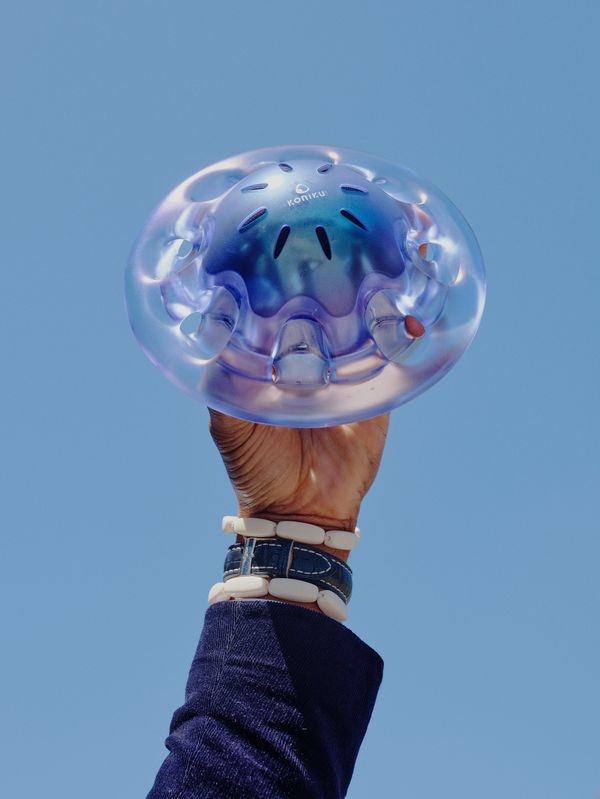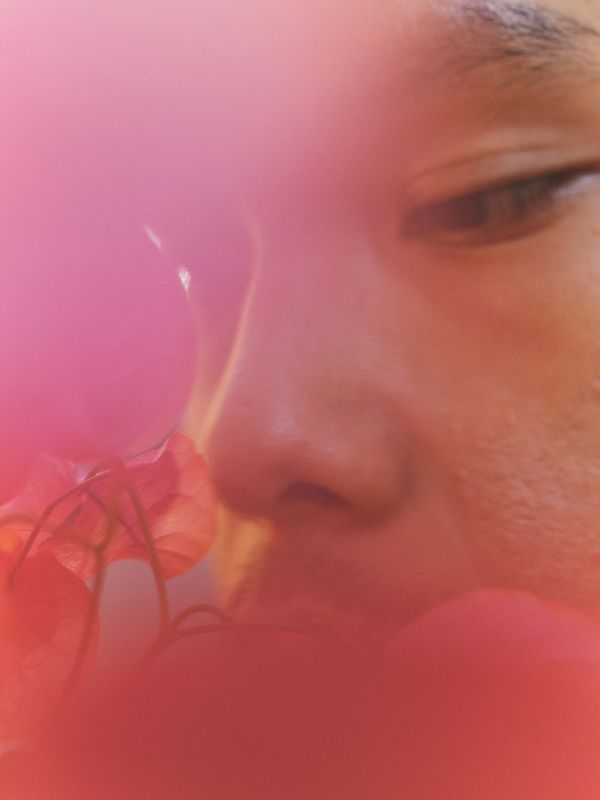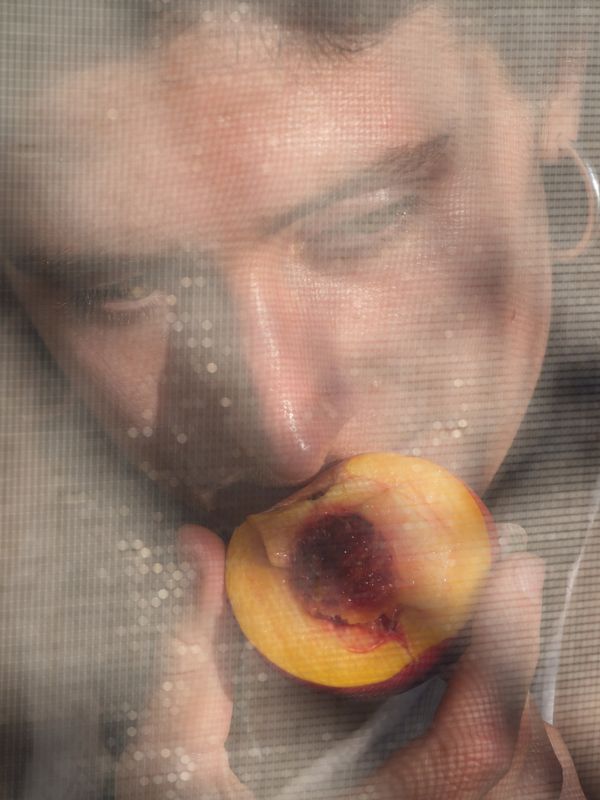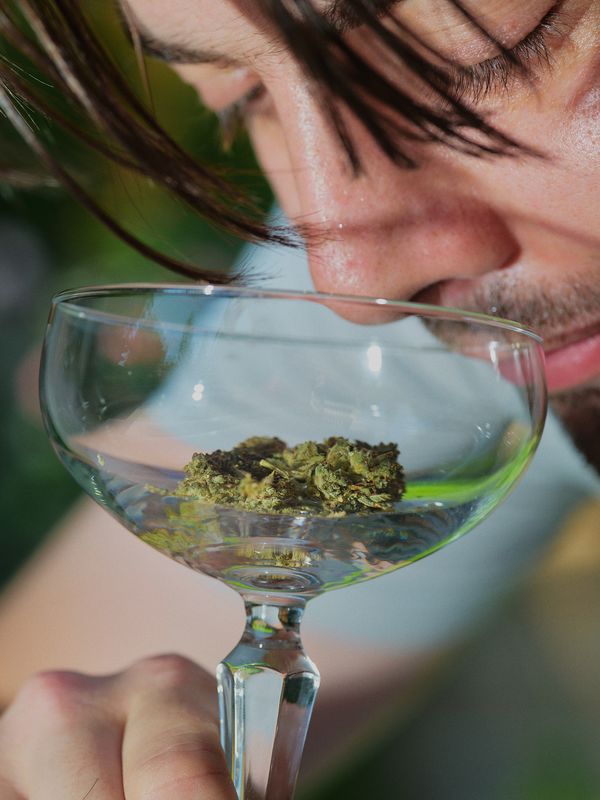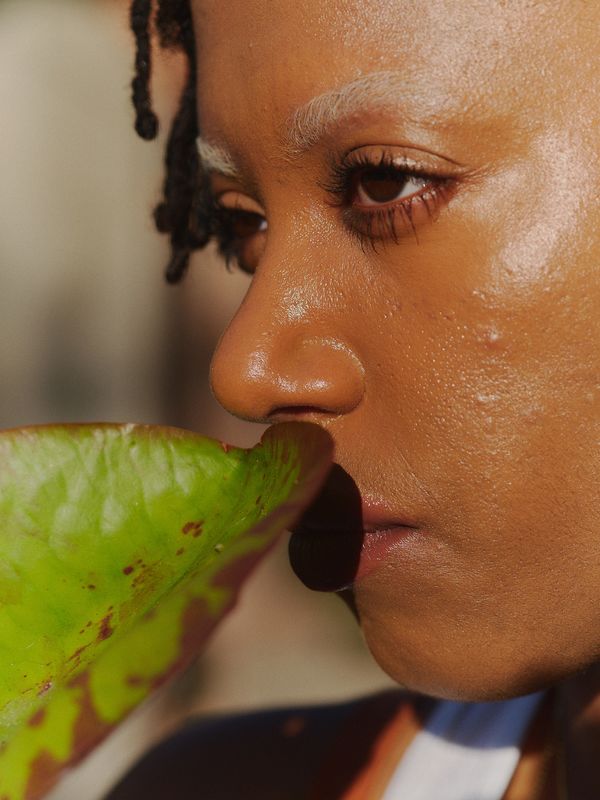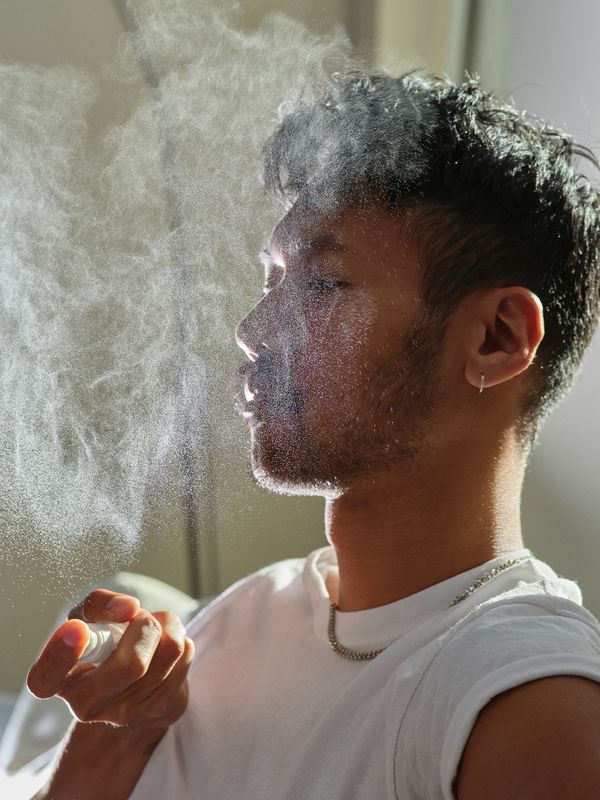A new generation of companies is homing in on one of the hardest problems in tech: replicating our sense of smell.
Osh Agabi’s solution to one of biotechnology’s thorniest problems looks like an iridescent purple nipple the size of a steering wheel. Other than that, it’s inconspicuous. It doesn’t beep or pulse or hum. Hanging from a wall, it just sits quietly and smells.
Airports, arenas, factories, people—they all stink, and they stink in particular ways. We know this because our noses tell us so. But attempts to re-create our oldest sensory experience with machines and technology have been woefully lacking. Modern everyday devices might be smart enough to recognize our faces and voices, read our pulses, and track our motions, but they can’t smell. The best example of a commercial device that can reliably pick up chemical signals in the air hasn’t changed in years. It’s called a smoke detector.
But Koniku Inc., which Agabi founded in 2015, says it’s landed upon a sensory breakthrough. In July the company struck an agreement with the world’s biggest brewer, Anheuser-Busch InBev SA/NV, to deploy the Konikore, as the purple bubble is called, to measure how a beverage’s aromatic notes are perceived and experienced by the nose, with the aim of enhancing flavor. And in the next few weeks, the Konikore is expected to start showing up in some U.S. airport terminals, thanks to a partnership with Airbus SE that’s geared toward bomb detection. Koniku has also signed a development deal with electronic sensor manufacturer Thermo Fisher Scientific Inc. to create a method for detecting traces of marijuana on people suspected of driving under the influence.
“What the camera did for vision, we’re now doing for smell,” Agabi says. “I believe we are the first company to build a smell camera on the smell sidewalk.” The difference with Koniku’s “camera” is that the purple encasement contains tiny living nerve cells. They’re suspended inside a proprietary solution designed to replicate the mucosa, the layer of membrane high up in our nasal cavities. The cells contain specific transmembrane proteins programmed to recognize odor molecules, precisely as those in our nose would catch a whiff. The reaction triggers a cascade of signaling events, eventually leading to a chip reader that interprets which receptors were triggered. And there you have it: the authentic recognition of an odor.
Koniku is one of at least three startups attempting to bring their biotechnological achievements in odor detection out of the laboratory. Together they’re racing for investors, customers, and regulatory approval. One of them, Aromyx Corp., in Mountain View, Calif., has been testing how its own receptor-based platform reacts in the presence of a variety of diseases, including pancreatic cancer, prostate cancer, and malaria. And that got started before a viral pandemic forced the world to reconsider what could be wafting around us in the air. Aromyx’s vision is to reduce the size of the instrument that underlies the technology of its lab-based system to the size of a pregnancy test, capable of telling you that you have cancer or Covid-19 (or, better yet, nothing). In addition to Aromyx and Koniku, there’s Aryballe, a French startup that’s attracted backing from Samsung Electronics Co. and Hyundai Motor Co. for its handheld sensor, the NeOse Advance. Aryballe’s device contains peptides, or fragments of proteins, that operate in gas rather than liquid like the Konikore.
For Avery Gilbert and other veteran smell scientists, the battle for smell-sensor supremacy is reminiscent of the late 1990s and early 2000s, when advancements in olfactory research brought about a flurry of electronic devices with catchy names—AromaScan, the Cyranose, ScenTrak. None lived up to their hype and became anything close to a universal odor reader. Gilbert says a biological sniffing system has the potential to do much more. “My feeling is it’s got to be way more efficient,” he says. “You’re using what mammalian noses are using. It’s much closer to what we’re smelling and wanting to smell.”
“Why has it always been so difficult to solve olfaction?” Agabi asks. “The physics that rely on it are quite hard. Vision, comparatively, is an easy problem. When people see something, you have these photons that interact with sensors that convert that energy. Pretty straightforward, because these are energy particles by definition. Sound is a compression of air—an energetic particle. But smell is a different beast.”
Compared with what we know about vision and hearing, our understanding of the olfactory process, whether the inhalation of a molecule or the perception of an odor, remains in the Dark Ages. Here’s what we do know: About 400 receptor types in our noses capture ambient molecules bobbing about in the air. These molecules trigger a complex chain reaction ultimately transforming into a perception, a signal. The signal pinballs its way around our brains: a coffee, dark roast; Christmas morning; Mom’s kitchen.
Our nasal receptors are capable of discriminating billions, if not trillions, of smells, particularly ones that act as flavor components for food or drink. The newest smell technology tries to mimic this by drawing on an array of disciplines, from neuroscience and organic chemistry to machine learning, data science—and, more recently, epidemiology. For obvious reasons, scent-based disease detection has gotten a fresh look over the past year. To some, the dream of a device that can blend into the background and monitor someone’s breath or sweat for illness has never been closer to reality. Then again, if smell technology has been consistent about one thing over the years, it’s a failure to deliver on its promises.
When I first spoke to Josh Silverman, the chief executive officer of Aromyx, it was in January 2020. Reports about a mysterious virus in China were beginning to circulate. Silverman’s company was focused primarily on using its platform to help flavorists discern which aromas were activating certain receptors, in an effort to enhance the taste of, say, a plant-based meat or an artificially sweetened beverage.
The system had also been used to analyze urine samples of prostate cancer patients since 2019. When Covid became a worldwide pandemic, the potential for Aromyx to produce a touch-free diagnostic tool became the company’s new raison d’être. “I’ve seen the reports saying that dogs are being used in airports to ‘smell’ the virus on travelers,” Silverman says. “That’s not really possible. What they’re smelling is the molecular byproducts that have been altered by the virus and get diffused as sweat. Our scent platform can detect those changes the same way.”
The idea of diagnosing diseases through smell started with the Greeks, but it really took off with the “piss prophets” of the 18th century. Until then, doctors routinely classified maladies based on the look, scent, and even taste of a person’s urine. The famed physician Thomas Willis described the urine of a diabetic as sweet as honey or sugar. Shortly thereafter emerged the piss prophets, who told fortunes through “uromancy.”
Modern medical journals still occasionally refer to odors that sick people emit. One list compiled in a 1998 article includes yellow fever (raw meat), typhoid (baked bread), and diabetic ketosis (rotten apples). In 2019, researchers confirmed the account of a woman in Britain who’d reported smelling the biomarkers of her late husband’s Parkinson’s disease, a decade before he was officially diagnosed.
Because smell is so subjective, not to mention that doctors might miss something if they have a bout of hay fever, it’s not generally considered a reliable diagnostic method. But the fragrant properties of a disease can tell us something, with the right sensor. When a virus attacks a healthy cell, it alters the cell’s metabolic activity, producing abnormal byproducts that enter the bloodstream and are eventually excreted via breath, sweat, or urine. These byproducts, which can include acetone, isoprene, and methanol, are classified as volatile organic compounds, or VOCs.
Healthy individuals can produce thousands of VOCs in a single breath. A sick individual might exhale the biomarkers of a disease. “In theory, this should be the earliest possible detection of any possible infection event,” Silverman says. “You’re measuring the output of an infected cell. That can happen far before you get any viral replication.”
All that remains will be to successfully scale up its olfactory technology, safely prepackage the receptors, make it easy enough to use in a doctor’s office, and convince the U.S. Food and Drug Administration of its harmlessness. Success is far from assured, but Aromyx plans to start trying this fall.
In 1999, Steven Sunshine was the CEO of a startup in Pasadena, Calif., called Cyrano Sciences Inc.—as in de Bergerac, the lovesick troubadour with a famously overdeveloped proboscis. Cyrano’s first electronic nose, the Cyranose 320, was based on a sensor array invented by Nathan Lewis, a chemist at the California Institute of Technology. Polymer plastics in the array, Sunshine says, responded to chemical odorants by expanding, like a sponge, in a readable and reproducible manner.
The system was crude and somewhat fallible, but the plastics’ absorption rate differed depending on its exposure to certain vapors, giving the impression of operating like a nose. The polymer-based approach was also faster, cheaper, and smaller than the gas chromatography-mass spectrometry systems long used for identifying the molecular composition of gases. Cyrano could put its e-nose into a device the size of a two-way radio. It quickly attracted more than $12 million in investment and led to a partnership with Hewlett-Packard Co. “We were very much at the leading edge of the e-nose movement,” Sunshine says. “Here was this major sense that we all have that had never really been effectively replicated. What that could mean across so many different areas was intriguing.”
Global Electronic-Nose Market
By industry
Data: Mordor Intelligence
He fielded requests from potential clients hoping to monitor things such as fish processing in Alaska and municipal water treatment facilities in Los Angeles. Cyrano also looked into diagnostic applications, including whether the Cyranose could accurately detect early stages of lung cancer. One company purchased the system to smell whether refillable 5-gallon water jugs had been used for anything other than water. “There’s all sorts of jobs for things you never realized,” he jokes.
But the tech had limitations. “The challenge is around edge cases,” Sunshine says. “What happens if you see something you’ve never seen before? Somebody comes in that doesn’t have lung cancer, but they have something else? Are you going to be able to differentiate that?”
The problem is essentially signal vs. noise. “We’ve had chemical detectors for years,” says Stuart Firestein, an olfactory researcher and the former chair of Columbia’s department of biological sciences. “As long as you know exactly what chemical you’re looking for, you can usually build a detector that will find it.” Take coffee. If you grind up pretty much any bean and put it through a gas chromatograph, you’ll find that around 750 chemicals make up its odor. “But I can tell you, because I was at the laboratory of Kraft Foods some years ago,” Firestein says, “we don’t need all 750 of them. They have 35 odors that when they put them together, it’s indistinguishable from coffee.”
With every sniff, odorants flood our twin nasal passages. Most are filtered away from our olfactory receptors, flowing straight down the back of the throat or getting caught in the dusty webbing of dried mucus and hairs. The remaining odorants have to move at the right speed, slowly, across the olfactory sensors for us to smell them. The evolutionary design of this system isn’t as powerful for humans as it is for other creatures; dogs have almost 20 times the sensor surface area, allowing for a much greater concentration of olfactory neurons. Small wonder that Charles Darwin recognized the nose as being “of the highest importance” to most mammals but of “extremely slight service” for humans.
Immanuel Kant, for his part, called smell the “most ungrateful” and “most dispensable” of our senses. It’s clearly the hardest to quantify. We don’t know exactly why some chemicals add up to “coffee” or “popcorn” or “gasoline.” We also have no objective scale by which those fragrances can be measured. We can say the smell of honey is closer to vanilla than it is to citrus, but by how much? Perfumers, fragrance companies, and businesses such as Yankee Candle Co. have constructed massive, intricate libraries of chemicals that, when mixed, can approximate the aroma of a meadow of flowers or a freshly cut lawn. But working in the reverse direction is a tall task. “It’s the overriding question of the field,” Firestein says.
Advancements in artificial intelligence have made data gathering easier than in the past, when you had to build a device’s database by exposing the sensors to individual odors one by one. And the more Cyrano had to tailor its devices for different clients, the thinner the profit margins spread. “You have this incredibly huge landscape of what you could possibly go do,” Sunshine says, “and it takes probably more work than anybody really realizes to triage those opportunities.”
In 2004, London-based Smiths Group Plc purchased Cyrano for $15 million, with plans to use the Cyranose for national security applications. Opportunities for expanding into other areas dried up, Sunshine recalls; he left the company a couple of years later and started TixTrack Inc., a ticketing software company. “I’m still a believer,” he says.
The great recent hope of the field traces to 1991, when Columbia researchers Linda Buck and Richard Axel discovered genes in human DNA that produce specific protein receptors attached to olfactory nerve cells. The confirmation of the existence of “odor receptors”—proteins that pick up smell molecules and excite olfactory neurons transmitting signals to the brain—represented a seismic breakthrough in the science of smell. “I was moved by Nature’s marvelous invention,” Buck later wrote of the discovery. In 2004, she and Axel won the Nobel Prize in Physiology or Medicine for their work.
The two scientists posited that receptors interact with odorants sort of like a lock and a key. The exchange ultimately produces an electric signal that gets sent to and interpreted by the brain. Things get complicated, though: Each type of receptor can respond to several different molecules, and vice versa, with varying intensity. Much as the 26 letters of our alphabet can yield close to a million English words, our small family of odor receptors is capable of perceiving a galaxy of smells.
Genetics play an important role in that perception, by modifying how some receptors function. It’s the reason about 2% of the population finds the smell of skunk to be mildly pleasant. Some people think cilantro smells like soap, and others liken it to lemon. Scientists have tried to base smell theories around “primary odors,” assigning very basic classifications—salty and sweet or salty and bitter—to smells as they have with tastes. But attempts at neatly organizing smells quickly unravel, in part because they’re so subjective. Odors are wrapped up in experience—the indelible musk of your husband’s favorite T-shirt, the musty reek when you open the attic door—and we tend to classify them reflectively. Does it smell good? Does it smell like it’s supposed to? Should I eat its source?
Building a machine that could distinguish constantly and with empirical certainty which chemicals are flooding by, and through, us as we move about the world seemed more plausible after Buck and Axel’s discovery. Except that the odor receptors proved uniquely challenging to study. For reasons that still aren’t entirely clear, the genes put up a strong resistance to heterologous expression, a standard technique for converting a gene into a functioning protein in a different host cell. Without that step, scientists had a hard time understanding and re-creating olfactory receptors until researchers at Duke University achieved heterologous expression for them in 2011.
Aromyx found that additional “chaperone” proteins could be cloned and introduced to help the receptors function in a very unnatural cell environment: plastic dishes in a lab. The company also added an additional protein, luciferase, that would generate photons to mimic the voltage change carried by neurons into the brain. A reader could then detect the resulting flash of light. “The key is we’re keeping as much of the normal signal cascade as we can,” Silverman says, “while still giving us a quantitative readout of the information that would otherwise be going to the brain.”
Aromyx’s laboratories sit in a flat, beige research park with stucco roofing 10 minutes south of the Google campus in Mountain View. It’s raised $18.8 million since 2015 and counts six people with doctorates among its 15 employees. Together they’ve produced “more functional odor receptors than anyone else in the world,” Silverman says. Even if that’s the case, it’s only about 100 receptor types out of the 400. But, Silverman says, not all receptor types are distributed evenly in the nose. Some have thousands, if not millions, of copies, whereas others are more rare. “At the moment,” he says, “we have receptors that cover about 95% of the real estate of the human nose.”
Silverman says Aromyx is profitable and is working with five Fortune 500 companies on a range of applications, including determining how to improve the tastes of alternative ingredients, scrubbing the odors from recycled plastics, and tracking the stages of fermentation in biologics. One limitation of its current solution is the lack of portability. Clients have to send samples to Mountain View to be tested and analyzed in a sterile setting for the receptors to work. A second limitation is that its technology can only analyze one odor at a time, meaning the cells can’t be reused for multiple tests. But Silverman says reusability isn’t a major priority for Aromyx; he often compares the instrument to a blood glucose test, a highly common, single-use measurement containing a living enzyme that slowly perishes upon exposure to air. “It comes down to what’s the data you’re trying to get,” he says. “When you’re trying to diagnose cancer, do you really need to be able to measure every second of the day for days or weeks in a row? You either have cancer or you don’t.”
As for Aryballe, the French startup building sensors with biological components, CEO Sam Guilaumé says it counts Hyundai, Samsung, and International Flavors & Fragrances among the backers of its proprietary NeOse device, a handheld smell walkie-talkie with biosensors grafted onto a high-speed silicon platform. Instead of expressing the full olfactory receptor protein, Aryballe uses 64 peptides—fragments of proteins—that Guilaumé says work in concert to build an “image” of the odor they bind with. That image is later compared with others in Aryballe’s olfactory library. The platform has been reduced to the size of a paper clip, which potentially helps with integration into existing smart-sensor networks. Hyundai, which invested in Aryballe in 2019, has been testing the sensors to monitor smells in its cars.
The other main startup working on a biological approach is Koniku. For four years, Agabi’s company has doggedly pursued the development of an always-on device analogous to the sensors on our faces. Coming iterations of the Konikore should prove more portable than the current wall-hanging one. Koniku’s olfactory neurons can currently survive in their solution for a month before needing replacement. Agabi says inventing a method to keep them alive was a critical first step toward a more idealized electronic reproduction of the nose. (Koniku comes from the Yoruba word for “immortal.”) With that problem solved, he can continue to modify protein genes, Frankensteining olfactory receptors that are keen to bind with spoiled fish, or perfume knockoffs, or the early traces of an infectious disease. “I’ve developed a process that can be tailored to anything,” Agabi says. “It doesn’t work for just explosives. It works for any kind of compounds I’m interested in, and I can essentially repeat the process.”
Whether the system is effective and economical enough to satisfy commercial clients is the next question. One test of Konikore devices, conducted last October by Airbus with the police department of Mobile, Ala., suggested they performed better at bomb detection than trained dogs did. But the biological approach has its skeptics. “I’ve always worried about the robustness of the biological systems,” says Julian Gardner, a professor of electronic engineering at the University of Warwick in England and the designer of the world’s first commercial electronic nose. “The automotive industry says, ‘We want something that will work for 20 years, in temperatures from –40 degrees to 90 degrees humidity, and it has to cost less than $1.’ That’s the environment you’re working in.”
Gardner’s first groundbreaking invention, built in 1993 with Warwick doctoral student Tim Pearce, was a 12-sensor array of conducting polymers, initially used to help Bass Brewers detect fouled batches of beer. Gardner has since written two books on machine olfaction and helped found three electronic nose companies whose simple, AI-equipped metal-oxide gas sensors for things such as ethanol and carbon monoxide are today found in millions of households, factories, and automobiles. In his view, it’s unlikely that olfactory receptors will ever attain that type of commercial reach. Most solutions using them have ignored or not yet tailored a solution that allows for durability—for sensors to stay functional beyond their initial use. Human olfactory receptors are “born, they grow, they learn, and they die and get washed away,” Gardner says. “You can do it [as a single-use measurement], but it’s a completely different system. It’s not a sensor.”
The biology proponents are undeterred. “You can stick a beer into a gas chromatograph and it will tell you every single chemical component,” Agabi says. “But there are things that a chemical device will pick up that your nose or taste doesn’t code for or care about. We built a system that gets as close as it can get to what taste is perceived as. We’re giving you a human filter—an accurate picture of the human perception of smell.”
Source: Replicating Our Sense of Smell Is One of the Hardest Problems in Tech – Bloomberg



